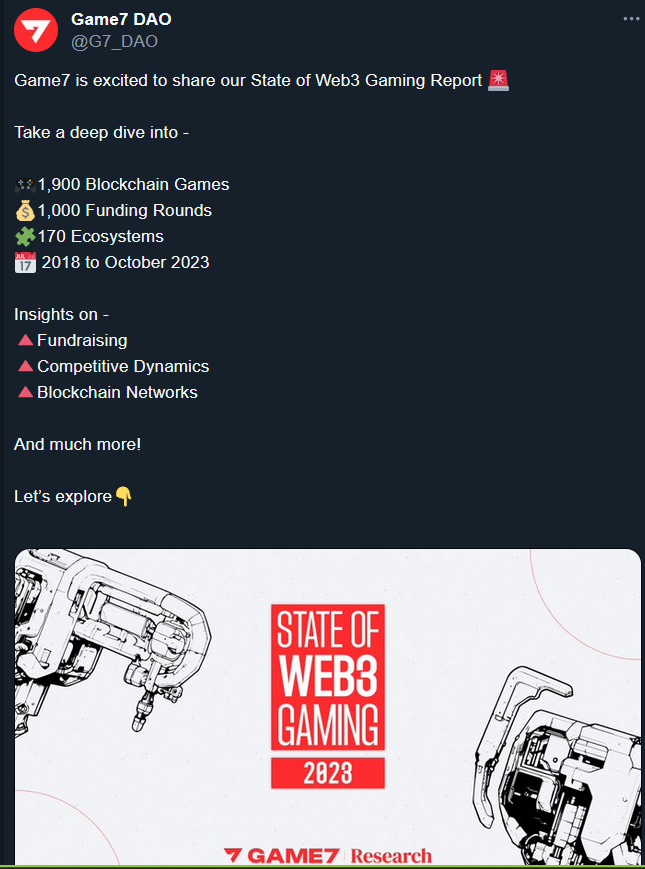Ahri's unqualified thoughts #63
Easy to consume content: 1 quote, 1 tweet/storm and 1 article/video.
In this edition, we're focusing on two topics: firstly, a comprehensive report from G7DAO on the state of Web3 Gaming in 2023, and secondly, an insightful article examining Valorant's successful strategy.
1 quote
“Life is good, y’know what I mean?” Future
1 tweet/storm
DISCLAIMER: this report, like any other report you’ll find on internet, is done with a vested interest and a certain bias. Please, take it with a grain of salt. I invite you to read the whole report, but here’s an extract from their tweet:
Since 2018, a staggering $19B has been funneled into Web3 gaming-related projects. The Web3 gaming market continues to grow, albeit slower after the 2022 market correction. Until Q3, blockchain gaming-related rounds reached $1.5B in 2023, with more than $800M being exclusive to Web3 gaming, while the rest was shared across multiple verticals.
APAC hosts the majority of Web3 game developers (40%), followed by North America (30%). This year, half of the new games entering the space were based in Asia.
In 2023, more than 81 new blockchain networks that target gaming were announced, growing by 40% YoY. The majority of Web3 games (81%) are using general-use L1 networks, with EVM sidechains marking a significant portion.
On my end, while I am less bullish than before on the current state of web3 gaming, I remain involved in certain ways. Most of my discussions about this industry lead me to think that developers should focus on what makes blockchain unique (and no, I’m not speaking about interoperability or assets ownership), rather than try to make traditional games with tokens/NFTs.
1 article/video
Cecilia d’Anastasio, an excellent journalist covering gaming for Bloomberg, wrote an insightful article about how influencers have helped shape Valorant into a cultural phenomenon, particularly in the U.S. This piece features insights from Rachell “Valkyrae” Hofstetter, a well-known gaming influencer, and Daniel “ZhugeEX” Ahmad, who I consider the greatest gaming analyst of all time (and that's my honest, unbiased opinion). It also includes input from several key stakeholders at Riot Games. The full article is available for a more in-depth read. Here's a TLDR:
Influencers like Valkyrae, have significantly contributed to Valorant's popularity, attracting millions of followers. The game's integration into pop culture, particularly among young adults, is evidenced by its trendy, high-fashion energy and its appeal to a wide range of players, including those who might not traditionally engage with technical or magic-themed games.
As per Riot’s words: Valorant's design and ethos are "fresh" and "unapologetically international," appealing to a diverse, global audience. This shows in its character designs, such as the Chinese healer Sage or the half-Filipina character Neon, reflecting the cultural diversity of its player base. Riot's successful expansion of Valorant into the Chinese market, resulting in millions of views, highlights the game's global appeal.
Valorant's revenue model, focusing on selling cosmetic skins for guns instead of character costumes helped tremendously on the revenues side. These skins, while purely aesthetic, have become a significant source of revenue, as seen in the substantial sales increase from cosmetic bundles associated with Valorant tournaments.
Riot actively engages with the Valorant community, incorporating feedback from streamers and players into the game's development. This interaction not only enhances the game's appeal but also creates a sense of ownership among players and influencers, further driving the game's cultural significance and business success.
The article dives on all of the above topics, while also recounting the game challenging launch during the first pandemic.
Last but not least, I haven’t tackled the esports aspect of things - let’s leave that for another day :).





